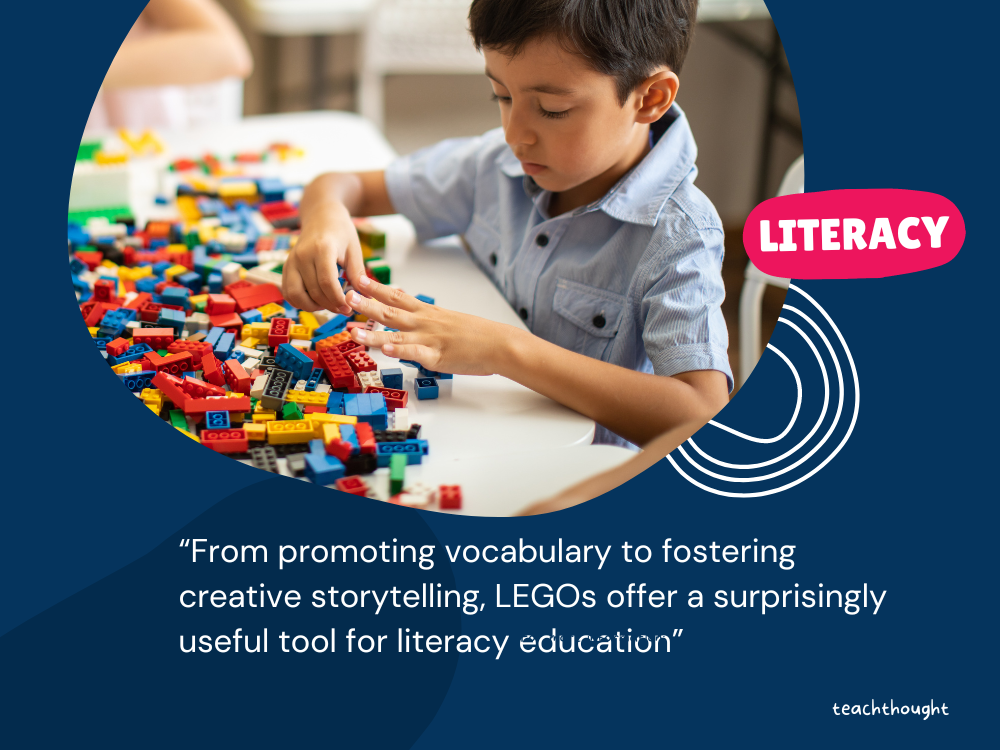by TeachThought Staff
In the classroom, promoting literacy is a practice that extends far beyond the mere ability to read and write.
Literacy is part of broad spectrum of competencies, including language acquisition, comprehension, critical thinking, and creative expression. Within this expansive understanding of literacy, we find the value of seemingly simple tools, like LEGO bricks, which can play a pivotal role in promoting literacy in innovative and engaging ways.
With their universal appeal and inherent flexibility, LEGOs offer a unique platform for literacy development. At first glance, these colorful building blocks might seem far removed from the traditional tools associated with reading and writing. However, upon closer examination, it becomes evident that LEGOs can facilitate a deep engagement with the foundational aspects of literacy, particularly in the early years of a child’s development.
The integration of LEGOs into literacy education is grounded in the principle of learning through play. This approach aligns with the understanding that children are naturally curious and learn best when actively engaged and enjoying themselves.
What Does ‘LEGO’ Stand For?
‘LEGO’ is an abbreviation of Danish meaning ‘leg godt,’ meaning ‘play well.’
By leveraging the playful nature of LEGOs, educators and parents can create a naturally literacy-friendly environment. For instance, when children follow instructions to build LEGO models, they’re not just manipulating bricks but engaging in decoding symbols and texts, which mirrors the reading process. This hands-on experience with following instructions enhances their ability to understand and follow written narratives, thereby strengthening their reading comprehension skills.
How Can LEGO Building Blocks Be Used In The Classroom?
LEGOs can also serve as a powerful tool for vocabulary development. As children describe their creations or the scenarios they’re enacting, they naturally expand their descriptive language, learn new words, and practice articulating complex ideas. This verbal expression is a critical literacy component, reinforcing understanding and communication skills. Educators can further this development by engaging with children about their LEGO projects, asking open-ended questions that encourage more detailed responses and deeper thinking.

Creative storytelling is another literacy skill that LEGOs can improve. Children embark on a journey of narrative exploration by building scenes and characters out of LEGO LEGOs. They learn to construct stories with a beginning, middle, and end, develop characters, and introduce conflict and resolution.
This approach can boost their imaginative capabilities and help them understand the structure of stories, a key element in literacy. Educators can capitalize on this by encouraging children to write down their LEGO stories, thus bridging the gap between oral and written storytelling.
In the classroom, LEGOs can also be utilized to support the teaching of reading and writing directly. Letters and words can be constructed out of LEGO bricks, making the abstract nature of the alphabet more tangible and interactive. For younger children, this tactile experience can solidify the recognition of letters and sounds, serving as a foundation for phonics instruction. For older children, LEGOs can be used to physically build sentences and explore complex grammatical structures, making the rules and patterns of language more accessible and engaging.
The collaborative potential of LEGO play further enhances its literacy benefits. When children work together on LEGO projects, they practice communication, negotiation, and storytelling, all of which are essential literacy components. They learn to express their ideas clearly, listen to others, and contribute to a shared narrative, skills that are invaluable in oral and written communication.
Using LEGOs to promote literacy is a testament to the power of creative, play-based learning.
By tapping into LEGOs’ natural joy and engagement, educators and parents can support children in developing a wide range of literacy skills. From enhancing reading comprehension and vocabulary to fostering creative storytelling and written expression, LEGOs offer a surprising tool for literacy education. In the hands of a skilled educator, these simple bricks can be transformed into building blocks for a lifetime of literacy.
